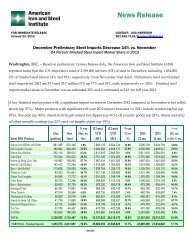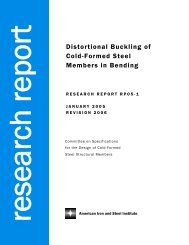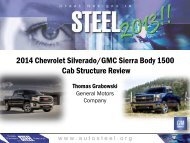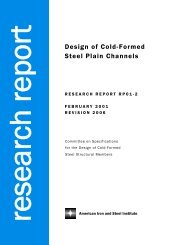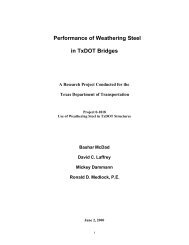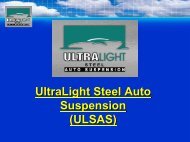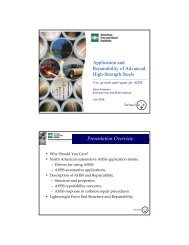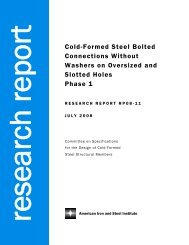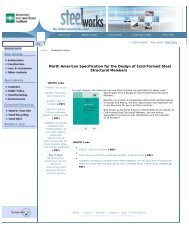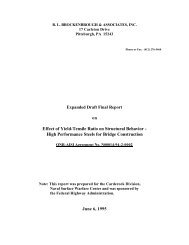Environmental Life Cycle Assessment of Southern Yellow Pine ...
Environmental Life Cycle Assessment of Southern Yellow Pine ...
Environmental Life Cycle Assessment of Southern Yellow Pine ...
You also want an ePaper? Increase the reach of your titles
YUMPU automatically turns print PDFs into web optimized ePapers that Google loves.
EXECUTIVE SUMMARY<br />
sample representing ~25% <strong>of</strong> poles in service, utilities have estimated the average wood pole service <br />
life as between 30 and 40 years. 10 This study uses the top end <strong>of</strong> the range from the survey: 40 years, <br />
corresponding to an annual average failure rate <strong>of</strong> 2.5%. <br />
1.3.2 Selected Functional Unit and Study Time Horizon <br />
For this study, the functional unit is the use <strong>of</strong> a system <strong>of</strong> one million 45-‐foot tall, Class 2/Grade B 11<br />
distribution poles over a 40-‐year period in the Southeastern US. In order to examine life cycle <br />
impacts <strong>of</strong> the poles in the most straightforward manner possible, this study assumes that steel and <br />
wood utility poles are functionally equivalent from the perspective <strong>of</strong> utility providers, and can be <br />
substituted on a one-‐to-‐one basis. <br />
This use encompasses only the required load-‐bearing support for distribution wires used in local <br />
power and telecommunications applications, not the use <strong>of</strong> the distribution wire infrastructure itself <br />
(i.e., electrical power distribution is excluded from the scope). The use <strong>of</strong> the wire infrastructure does <br />
not vary based on the type <strong>of</strong> support structure used, and was excluded from the scope. <br />
Additionally, the functional unit reflects the infrastructure required for supporting local distribution, <br />
not regional transmission, which requires a substantially different support infrastructure. A third <br />
alternative, the burial <strong>of</strong> distribution wires was not included in the study, as the goal <strong>of</strong> the study is to <br />
help inform decision-‐making between different pole material options. <br />
The timeframe <strong>of</strong> 40 years was chosen to capture differences in durability between the poles. The <br />
dynamics <strong>of</strong> the utility pole system over this 40-‐year period were assessed by including results at the <br />
beginning <strong>of</strong> the time horizon, and after 10, 20, 30, and 40 years. This provides clear “snapshots” <strong>of</strong> <br />
the benefits and trade-‐<strong>of</strong>fs <strong>of</strong> phasing in steel poles at several points in time. <br />
1.3.3 Scenarios Considered in the <strong>Assessment</strong> <br />
The study considers the use <strong>of</strong> the utility system in the Southeast given two different scenarios, with <br />
a scope that is cradle-‐to-‐grave for both: <br />
The “business-‐as-‐usual” scenario (“BAU” scenario). As Class 2 wood poles fail, they continue <br />
to be replaced by Class 2 wood poles. This is the typical practice in the region. <br />
The “steel pole replacement” scenario (“SPR” scenario). As Class 2 wood poles fail, they are <br />
instead replaced by Grade B galvanized steel utility poles. <br />
In both the BAU and SPR scenarios, the total number <strong>of</strong> utility poles in operation is held constant at <br />
one million poles, maintaining the same functional equivalency. The consequences to human health <br />
and the environment as a result <strong>of</strong> these two scenarios were assessed over a 40-‐year time horizon; <br />
the total number <strong>of</strong> poles <strong>of</strong> each type in service, for both scenarios, is shown in Figure 2. As can be <br />
seen, in the SPR scenario, after 40 years most (over 60%) utility poles are galvanized steel. <br />
10 Wood Pole Purchasing, Inspection, and Maintenance: A Survey <strong>of</strong> Utility Practice. Mankowski, M., et al. Forest Products <br />
Journal. 52(11/12): 43-‐50. 2002. <br />
11 IEEE 2012 National Electrical Safety Code (NESC). NESC-‐2012. IEEE Standards. 2012. <br />
April 2013 | ©SCS Global Services <br />
ES-‐ 6



